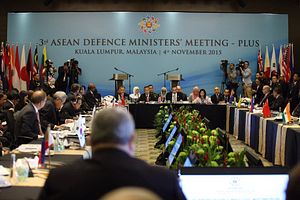Over the past few years, countries in the Asia-Pacific have become increasingly aware of the growing threats in the cyber realm, and have been boosting their capabilities in response. Malaysia is no exception, with the data clearly illustrating that government as well as companies are facing rising and more sophisticated cyber attacks (See: “Malaysia’s Cyber Defense: One of ASEAN’s Best?”).
In response, the Malaysian government has begun to increase the country’s capabilities. For instance, earlier this month, the country’s defense minister Hishammuddin Hussein confirmed that the military would finish setting up a new cyber defense center in the coming months. The new Malaysian Armed Forces Cyber Defense Operations Center (ATM CDOC) will become fully operational by September 2017 and will be in charge of monitoring cyber threats to the national defense system.
Apart from that, Malaysia has also increased the security of information in several key areas to reduce the threat to the nation’s critical infrastructure. The effort to secure what is known as Critical National Information Infrastructure (CNII) covers ten critical sectors including health, banking and finance, water, energy, information and communications, transport and defense and security.
Beyond undertaking these initiatives at home, Malaysia has also been working with other countries as well. Malaysian officials have said that they have collaborated with partner nations as they contemplate their own measures in a variety of ways, including information-sharing and capacity-building. These include initiatives at the regional level as ASEAN-wide initiatives that have begun to take shape, whether it be participating in forums like the inaugural ASEAN Ministerial Conference on Cybersecurity hosted by Singapore last October or advancing efforts through the new cyber working group within the ASEAN Defense Ministers Meeting Plus (ADMM-Plus) approved last year (See: “Singapore Unveils New ASEAN Cyber Initiative”).
While these measures are robust, Malaysian officials realize there is more to be done. Speaking at Singapore’s International Cyber Week (SICW) 2016 last October, Malaysia’s Science, Technology and Innovation Minister Madius Tangau stressed that Malaysia’s approach had to continue to be “revolutionary and innovative” as it seeks to develop a national cyber security innovation ecosystem to respond to increasingly sophisticated cyber threats.
Echoing this during his keynote remarks at a regional security meeting in Singapore this week, Hishammuddin urged his audience to “think outside the box” when confronting the cybersecurity challenge. Hishammuddin told delegates at the IISS Fullerton Forum, which precedes the Shangri-La Dialogue that will take place later this year, that in addition to conventional steps, Malaysia was also taking more innovative measures designed to either shape perceptions or broaden outlooks.
One example of this in Malaysia’s case, he said, was a cyber security awareness campaign that he had recently launched within his ministry. He also called for more collaboration between the government as well as academia, the private sector and internet activists.
“Tanks and troops protecting our borders will not mean anything if the technological infrastructure in which these systems are built upon are vulnerable and are prone to attacks,” he warned. While he was issuing a call for other Asia-Pacific countries to take the threat seriously, it was also an indicator of how much more Malaysia believes it has to do in its own ongoing war against cyber threats.

































